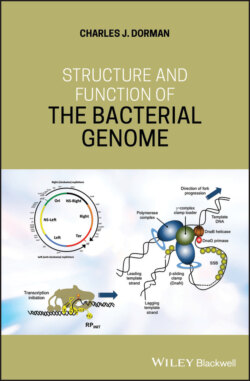Читать книгу Structure and Function of the Bacterial Genome - Charles J. Dorman - Страница 23
1.12 Some Bacteria Have More than One Chromosome
ОглавлениеAmong bacteria that have more than one chromosome are the well‐studied organisms A. tumefaciens (Allardet‐Servent et al. 1993), Brucella spp. (Jumas‐Bilak et al. 1998), Rhodobacter sphaeroides spp. (Choudhary et al. 2007; Suwanto and Kaplan 1989), and Vibrio spp. (Val et al. 2014). Of the organisms listed here, A. tumefaciens, has one circular and one linear chromosome; the others have two circular chromosomes. Paracoccus denitrificans is a bacterium that has three chromosomes (Winterstein and Ludwig 1998).
Are all of the chromosomes in a multi‐chromosome genome ‘equal’? It appears that one chromosome is usually the primary replicon, with the other being relegated to secondary chromosome status. For example, the two chromosomes of the pathogen V. cholerae are designated chromosomes, ChrI and ChrII, with ChrI having the majority of the metabolically important and virulence‐associated genes. ChrII does harbour essential genes, so its designation as a second chromosome is justified, despite its having plasmid‐like features. For example, the origin of replication of ChrII shows structural features that are similar to those of plasmids, which is consistent with the secondary chromosome having evolved from an ancestral plasmid (Orlova et al. 2017). The plasmid‐like nature of ChrII is also emphasised by its encoding plasmid RK2‐like toxin systems that ensure post‐segregation killing of those V. cholerae cells that lose ChrII (Yuan et al. 2011). The replication initiation system of ChrI resembles that of E. coli: initiation of replication of each chromosome is independent of, but coordinated with, that of the other (Duigou et al. 2006). ChrII begins replicating later in the cell cycle than the larger ChrI, but both finish together. This has been interpreted as a mechanism that compensates for the differences in size of the two molecules and the need to end replication simultaneously so that the chromosomes can be segregated together and that any dimers can be resolved simultaneously (Rasmussen et al. 2007). Further investigation has revealed the generality of coordinated termination of replication in members of the Vibrionaceae with two chromosomes (Kemter et al. 2018). ChrI and ChrII each possess their own ParAB‐parS systems and use these for efficient segregation of chromosome copies at cell division (Fogel and Waldor 2005; Yamaichi et al. 2007, 2011).
